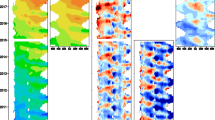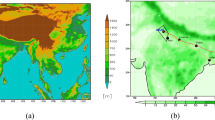Abstract
Satellite observations of atmospheric CO2 are able to truly capture the variation of global and regional CO2 concentration. The model simulations based on atmospheric transport models can also assess variations of atmospheric CO2 concentrations in a continuous space and time, which is one of approaches for qualitatively and quantitatively studying the atmospheric transport mechanism and spatio-temporal variation of atmospheric CO2 in a global scale. Satellite observations and model simulations of CO2 offer us two different approaches to understand the atmospheric CO2. However, the difference between them has not been comprehensively compared and assessed for revealing the global and regional features of atmospheric CO2. In this study, we compared and assessed the spatio-temporal variation of atmospheric CO2 using two datasets of the column-averaged dry air mole fractions of atmospheric CO2 (XCO2) in a year from June 2009 to May 2010, respectively from GOSAT retrievals (V02.xx) and from Goddard Earth Observing System-Chemistry (GEOS-Chem), which is a global 3-D chemistry transport model. In addition to the global comparison, we further compared and analyzed the difference of CO2 between the China land region and the United States (US) land region from two datasets, and demonstrated the reasonability and uncertainty of satellite observations and model simulations. The results show that the XCO2 retrieved from GOSAT is globally lower than GEOS-Chem model simulation by 2 ppm on average, which is close to the validation conclusion for GOSAT by ground measures. This difference of XCO2 between the two datasets, however, changes with the different regions. In China land region, the difference is large, from 0.6 to 5.6 ppm, whereas it is 1.6 to 3.7 ppm in the global land region and 1.4 to 2.7 ppm in the US land region. The goodness of fit test between the two datasets is 0.81 in the US land region, which is higher than that in the global land region (0.67) and China land region (0.68). The analysis results further indicate that the inconsistency of CO2 concentration between satellite observations and model simulations in China is larger than that in the US and the globe. This inconsistency is related to the GOSAT retrieval error of CO2 caused by the interference among input parameters of satellite retrieval algorithm, and the uncertainty of driving parameters in GEOS-Chem model.
Similar content being viewed by others
References
Andres R J, Marland G, Fung I, et al. 1996. A 1°×1° distribution of carbon dioxide emissions from fossil fuel consumption and cement manufacture. Glob Biogeochem Cycle, 10: 419–429
Baker D F, Law R M, Gurney K M, et al. 2006. TransCom 3 inversion intercomparison: Impact of transport model errors on the interannual variability of regional CO2 fluxes, 1988–2003. Glob Biogeochem Cycle, 20: GB1002, doi: 10.1029/2004GB002439
Bey I, Jacob D J, Yantosca R M, et al. 2001. Global modeling of tropospheric chemistry with assimilated meteorology: Model description and evaluation. J Geophys Res, 106: 23073–23095
Boden T A, Marland G, Andres R J. 1995. Estimates of global, regional, and national annual CO2 emissions from fossil-fuel burning, hydraulic cement production, and gas flaring: 1950–1992. Environ Sci Div, doi: 10.2172/207068
Bovensmann H, Buchwitz M, Burrows J P, et al. 2010. A remote sensing technique for global monitoring of power plant CO2 emissions from space and related applications. Atmos Meas Tech, 3: 781–811
Butz A, Guerlet S, Hasekamp O, et al. 2011. Toward accurate CO2 and CH4 observations from GOSAT. Geophys Res Lett, 38: L14812, doi: 10.1029/2011GL047888
Canadell J G, Corinne Le Quéré, Raupach M R, et al. 2007. Contributions to accelerating atmospheric CO2 growth from economic activity, carbon intensity, and efficiency of natural sinks. Proc Natl Acad Sci USA, 104: 18866–18870
Chevallier F, Breon F M, Rayner P J. 2007. Contribution of the Orbiting Carbon Observatory to the estimation of CO2 sources and sinks: Theoretical study in a variational data assimilation framework. J Geophys Res, 112: D09307, doi: 10.1029/2006JD007375
Cogan A J, Boesch H, Parker R J, et al. 2012. Atmospheric carbon dioxide retrieved from the Greenhouse gases Observing SATellite (GOSAT): Comparison with ground-based TCCON observations and GEOS-Chem model calculations. J Geophys Res, 117: D21301
Crisp D, Atlas R M, Breon F M, et al. 2004. The Orbiting Carbon Observatory (OCO) mission. Adv Space Res, 34: 700–709
Feng L, Palmer P I, Yang Y, et al. 2011. Evaluating a 3-D transport model of atmospheric CO2 using ground-based, aircraft, and space-borne data. Atmos Chem Phys, 11: 2789–2803
Gregg J S, Andres R J, Marland G. 2008. China: Emissions pattern of the world leader in CO2 emissions from fossil fuel consumption and cement production. Geophys Res Lett, 35: L08806, doi: 10.1029/2007GL032887
Gurney K R, Chen Y H, Maki T, et al. 2005. Sensitivity of atmospheric CO2 inversions to seasonal and interannual variations in fossil fuel emissions. J Geophys Res, 110: D10308, doi: 10.1029/2004JD005373
Houweling S, Breon F M, Aben I, et al. 2004. Inverse modeling of CO2 sources and sinks using satellite data: A synthetic inter-comparison of measurement techniques and their performance as a function of space and time. Atmos Chem Phys, 4: 523–538
Hungershoefer K, Breon F M, Peylin P, et al. 2010. Evaluation of various observing systems for the global monitoring of CO2 surface fluxes. Atmos Chem Phys, 10: 10503–10520
Ingmann P, Veihelmann B, Langen J, et al. 2012. Requirements for the GMES Atmosphere Service and ESA’s implementation concept: Sentinels-4/-5 and -5p. Remote Sens Environ, 120: 58–69
Kong S F, Lu B, Han B, et al. 2010. Seasonal variation analysis of atmospheric CH4, N2O and CO2 in Tianjin offshore area. Sci China Earth Sci, 53: 1205–1215
Liu L X, Zhou L X, Zhang X C, et al. 2009. The characteristics of atmospheric CO2 concentration variation of four national background stations in China. Sci China Ser D-Earth Sci, 52: 1857–1863
Marland G, Boden T A, Andres R J. 2008. Global, Regional, and National Fossil Fuel CO2 Emissions. In Trends: A Compendium of Data on Global Change. Carbon Dioxide Information Analysis Center, Oak Ridge National Laboratory, U.S. Department of Energy, Oak Ridge, Tenn., U.S.
Nassar R, Jones D B A, Suntharalingam P, et al. 2010. Modeling global atmospheric CO2 with improved emission inventories and CO2 production from theoxidation of other carbon species. Geosci Model Dev, 3: 689–716
NIES GOSAT Project. 2012. Summary of the GOSAT Level 2 data Products Validation Activity NIES GOSAT Project. 2010. Algorithm theoretical basis document for CO2 and CH4 column amounts retrieval from GOSAT TANSO-FTS SWIR. NIES-GOSAT-PO-017, V1.0
Ota Y, Yoshida Y, Yokota T. 2008. Study of retrieving column amount of carbon dioxide from satellite-based near-infrared observation of solar scatter light in clear sky condition-Error estimation optimization of vertical pressure grid. J Remote Sens Soc Japan, 128,2: 152–160
Reuter M, Bovensmann H, Buchwitz M, et al. 2011. Retrieval of atmospheric CO2 with enhanced accuracy and precision from SCIAMACHY: Validation with FTS measurements and comparison with model results. J Geophys Res, 116: D04301, doi: 10.1029/2010JD015047
Schneising O, Buchwitz M, Burrows J P, et al. 2008. Three years of greenhouse gas column-averaged dry air mole fractions retrieved from satellite-Part 1: Carbon dioxide. Atmos Chem Phys, 8: 3827–3853
Solomon S, Qin D, Manning M, et al. 2007. Climate Change 2007: The Physical Science Basis, Contribution of Working Group I to the Fourth Assessment Report of the Intergovernmental Panel on Climate Change (IPCC). Cambridge: Cambridge University Press
Suntharalingam P, Jacob D J, Palmer P I, et al. 2004. Improved quantification of Chinese carbon fluxes using CO2/CO correlations in Asian outflow. J Geophys Res, 109: D18S18, doi: 10.1029/2003JD004362
Uchino O, Kikuchi N, Sakai T, et al. 2012. Influence of aerosols and thin cirrus clouds on the GOSAT-observed CO2: A case study over Tsukuba. Atmos Chem Phys, 12: 3393–3404
Wunch D, Toon G C, Blavier J F L, et al. 2011a. The total carbon column observing network. Philos Trans R Soc A-Math Phys Eng Sci, 369: 2087–2112
Wunch D, Wennberg P O, Toon G C, et al. 2011b. A method for evaluating bias in global measurements of CO2 total columns from space. Atmos Chem Phys, 11: 12317–12337
Yokota T, Yoshida Y, Eguchi N, et al. 2009. Global Concentrations of CO2 and CH4 Retrieved from GOSAT: First Preliminary Results. Sola, 5: 160–163
Zeng Z C, Lei L P, Guo L J, et al. 2013. Incorporating temporal variability to improve geostatistical analysis of satellite-observed CO2 in China. Chin Sci Bull, 58: doi: 10.1007/s11434-012-5652-7
Zhou T, Yi C X, Peter S B, et al. 2008. Links between global CO2 variability and climate anomalies of biomes. Sci China Ser D-Earth Sci, 51: 740–747
Author information
Authors and Affiliations
Corresponding author
Rights and permissions
About this article
Cite this article
Lei, L., Guan, X., Zeng, Z. et al. A comparison of atmospheric CO2 concentration GOSAT-based observations and model simulations. Sci. China Earth Sci. 57, 1393–1402 (2014). https://doi.org/10.1007/s11430-013-4807-y
Received:
Accepted:
Published:
Issue Date:
DOI: https://doi.org/10.1007/s11430-013-4807-y




